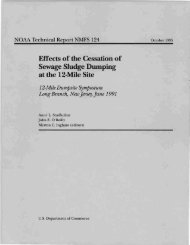Marine Flora and Fauna of the Eastern United States Platyhelminthes
Marine Flora and Fauna of the Eastern United States Platyhelminthes
Marine Flora and Fauna of the Eastern United States Platyhelminthes
You also want an ePaper? Increase the reach of your titles
YUMPU automatically turns print PDFs into web optimized ePapers that Google loves.
2 NOAA Technical Report NMFS 121<br />
ans in this manual, I generally follow <strong>the</strong> system proposed<br />
by Llewellyn (1970), as modified by Beverley<br />
Burton (1984) for <strong>the</strong> orders <strong>and</strong> families found on<br />
Canadian hosts. The exceptions are that Udonella has<br />
been removed from <strong>the</strong> Turbellaria, <strong>the</strong> microbothriids<br />
assigned to <strong>the</strong> order Microbothriidea Lebedev, 1988,<br />
<strong>and</strong> <strong>the</strong> monocotylids assigned to <strong>the</strong> order Monocoty<br />
!idea Lebedev, 1988.<br />
Only adult monogeneans are treated in this manual.<br />
The free-swimming oncomiracidial stage is not covered<br />
except to mention, in <strong>the</strong> systematic section, those species<br />
for which a description has been given. Monogenean<br />
species from estuarine <strong>and</strong> continental shelffishes<br />
are included while species from <strong>of</strong>fshore deep-water<br />
fishes are not. The nor<strong>the</strong>rn extreme <strong>of</strong><strong>the</strong> geographic<br />
range covered herein is <strong>the</strong> U.S.-Canada border; <strong>the</strong><br />
sou<strong>the</strong>rn extreme is Beaufort, North Carolina. Many <strong>of</strong><br />
<strong>the</strong> monogeneans listed below have a wider geographic<br />
distribution. Generally, only those reports from adjacent<br />
geographic regions are included; reports from<br />
o<strong>the</strong>r parts <strong>of</strong> <strong>the</strong> globe are not.<br />
Collection <strong>and</strong> Examination _<br />
Collecting monogeneans from freshly caught marine<br />
fishes most <strong>of</strong>ten involves examining <strong>the</strong> body surface<br />
<strong>and</strong> fins before removing gills by <strong>the</strong> following methods:<br />
1. Place <strong>the</strong> gills in a separate container <strong>of</strong> dilute<br />
formalin, e.g. 1 part concentrated (40% formaldehyde<br />
or "100%") formalin to 4,000 parts seawater (Pritchard<br />
<strong>and</strong> Kruse, 1982), which relaxes <strong>and</strong> fixes <strong>the</strong> worms<br />
with a minimum <strong>of</strong> contraction or distortion.<br />
2. Examine <strong>the</strong> fins, skin, scales, buccal cavity, nasal<br />
capsules, <strong>and</strong> cloaca <strong>of</strong> <strong>the</strong> fishes for monogeneans.<br />
3. Leave <strong>the</strong> material in <strong>the</strong> dilute formalin solution<br />
for approximately one hour, which is sufficient time to<br />
relax most specimens.<br />
4. Shake <strong>the</strong> container vigorously for about a minute<br />
to dislodge worms.<br />
5. Pour <strong>the</strong> liquid into a cylinder or o<strong>the</strong>r tall container<br />
<strong>and</strong> let it st<strong>and</strong> for several minutes to allow <strong>the</strong><br />
worms to settle.<br />
6. Decant <strong>the</strong> supernatant fluid <strong>and</strong> examine <strong>the</strong><br />
sediment in a petri dish under a dissecting microscope.<br />
7. Pipet worms into a fixative, such as 5% formalin or<br />
AFA (alcohol-formalin-acetic acid).<br />
An alternative method is to place <strong>the</strong> heads or whole<br />
fish directly into a fixative, such as 10% formalin or<br />
AFA, at a proportion <strong>of</strong> 2-3 parts fixative to 1 part gill<br />
material.<br />
Alternative methods for relaxing <strong>and</strong> isolating worms<br />
are given by Pritchard <strong>and</strong> Kruse (1982). For example,<br />
freezing <strong>the</strong> gills, branchial basket, or even whole fishes<br />
for 6-12 hours <strong>of</strong>ten aids in preventing mucus produc-<br />
tion by gill tissues <strong>and</strong> kills <strong>the</strong> worms in a relaxed state.<br />
However, for studies involving transmission electron<br />
microscopy, physiology, or behavior, carefully remove<br />
living worms from <strong>the</strong> host with <strong>the</strong> aid <strong>of</strong> a dissecting<br />
microscope. For scanning electron microscopy thoroughly<br />
wash worms by vigorous shaking in several<br />
changes <strong>of</strong>artificial seawater to remove attached mucus<br />
<strong>and</strong> debris before fixation (Halton, 1974).<br />
After specimens have been in <strong>the</strong> fixative for 12-24<br />
hours, transfer specimens to vials that contain internal<br />
labels <strong>and</strong> 70% ethanol for storage. However, specimens<br />
may be left in <strong>the</strong> formalin fixative almost indefinitely.<br />
Because <strong>of</strong> <strong>the</strong> importance <strong>of</strong> hamuli <strong>and</strong> marginal<br />
hooklets in taxonomy, small monogeneans such<br />
as Gyrodactylus spp. are usually mounted unstained on<br />
slides in glyceroljelly by using a double coverslip method<br />
(Pritchard <strong>and</strong> Kruse, 1982). However, ano<strong>the</strong>r staining<br />
method uses Gormori's trichrome solution with<br />
good results (Kritsky et al., 1978).<br />
Treat larger monogeneans in a manner similar to <strong>the</strong><br />
whole mount preparation techniques employed for digenetic<br />
trematodes. After fixing, store <strong>the</strong> worms in<br />
70% ethanol until stained. Most staining procedures<br />
use ei<strong>the</strong>r alcoholic carmine or aqueous hematoxylin.<br />
Several general parasitology laboratory manuals (e.g.<br />
Pritchard <strong>and</strong> Kruse, 1982; Meyer et al., 1992) provide<br />
detailed accounts <strong>of</strong> <strong>the</strong> fixation, staining, dehydration,<br />
clearing, <strong>and</strong> mounting techniques employed to study<br />
<strong>the</strong>se organisms. Cooper (1988) described <strong>the</strong> preparation<br />
<strong>of</strong> serial sections <strong>of</strong> platyhelminth parasites, which<br />
are useful in tracing <strong>the</strong> location <strong>of</strong> ducts <strong>and</strong> o<strong>the</strong>r<br />
structures.<br />
Several structures are important for <strong>the</strong> identification<br />
<strong>of</strong> Monogenea. Most important for identification<br />
<strong>of</strong> monogenean genera is <strong>the</strong> posterior attachment organ,<br />
or haptor, <strong>and</strong> its associated hard (sclerotized)<br />
structures (Figs. 1-4). The shape <strong>and</strong> nature <strong>of</strong> <strong>the</strong><br />
anterior attachment structures, reproductive system,<br />
<strong>and</strong> digestive system are also important in keying out<br />
<strong>the</strong>se worms (Figs. 1 <strong>and</strong> 2). The anterior attachment<br />
organ may comprise a pair <strong>of</strong> concave disklike structures,<br />
a pair <strong>of</strong> buccal suckers, head organs (paired,<br />
gl<strong>and</strong>ular duct openings), or a single, weak, oral sucker.<br />
The number <strong>and</strong> placement <strong>of</strong> <strong>the</strong> testes, presence or<br />
absence <strong>and</strong> shape <strong>and</strong> number <strong>of</strong> spines within <strong>the</strong><br />
male copulatory complex, shape <strong>and</strong> position <strong>of</strong> <strong>the</strong><br />
ovary <strong>and</strong> uterus, <strong>and</strong> position <strong>of</strong> <strong>the</strong> vagina(e) <strong>and</strong><br />
genital pore are all useful diagnostic characters. Eggs,<br />
when present in <strong>the</strong> uterus or ootype, can also aid<br />
identification. The intestine usually consists <strong>of</strong>a pair <strong>of</strong><br />
straight or highly branched ceca that end blindly or are<br />
confluent at <strong>the</strong> posterior end <strong>of</strong><strong>the</strong> body. However, in<br />
some <strong>of</strong> <strong>the</strong> larger species <strong>the</strong> intestinal ceca may be<br />
obscured by extensive vitellaria. In some taxa <strong>the</strong> shape<br />
<strong>of</strong> <strong>the</strong> pharynx is <strong>of</strong> taxonomic value.












